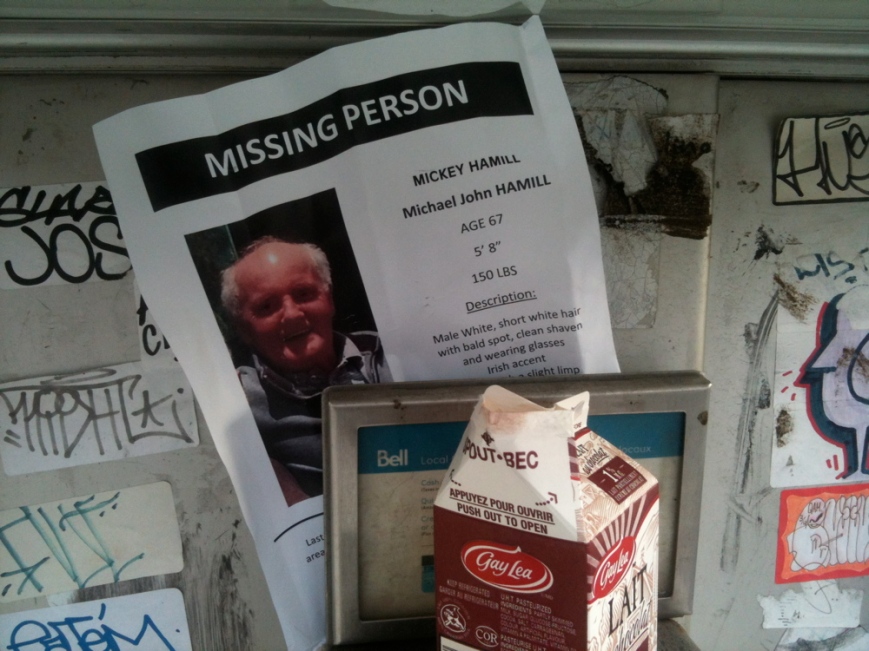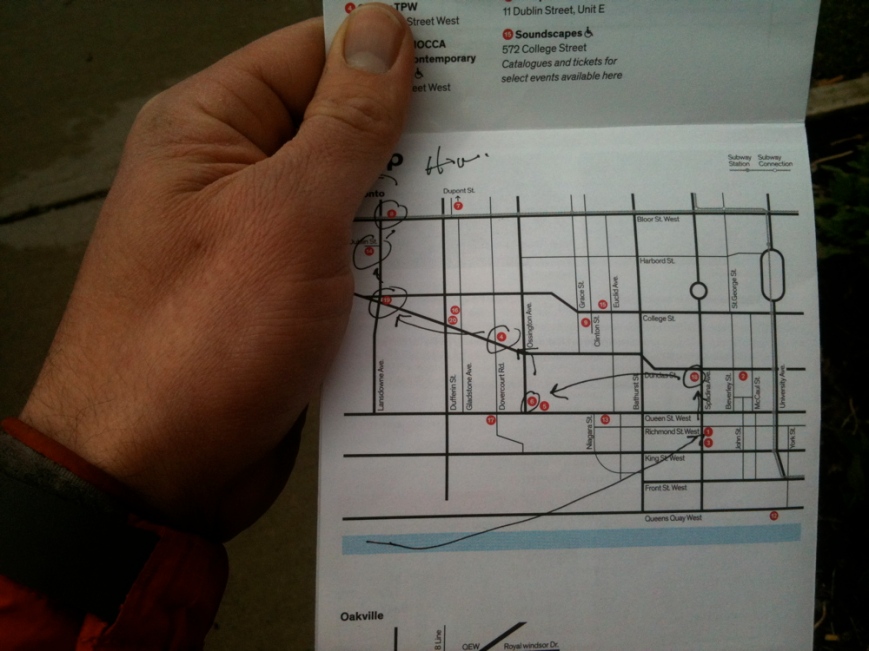The Images Festival kicked off last Thursday and runs until April 20th. While it’s one of the most significant film festivals in the city, and merges with other kinds of visual art in powerful and interesting ways, if you’re like me, it’s difficult to get to more than a few screenings. And because the programme is stacked with great films you may never get to see again, it’s necessary to plan ahead. In the four hour window I had on Saturday afternoon, I decided that instead of heading to the ravines of West End Toronto and across the sprawling suburbs for my weekend long run, I’d head downtown to visit as many of Image Festival off-screen programmes as possible.
The advantage of running downtown from the western part of the city is that one of the best routes is to run through High Park, and follow the jogging path along the lake. The route adds two kilometers to the route, but it’s remarkably calm and serene to be in the forest, and to have a quiet uninterrupted view of the lake for more about six kilometers. As a commuting route, it takes only about a half hour longer than getting downtown by other means. And it offers ongoing reminders of what the landscape was like before it so heavily developed. Along the east side of the park is a brook that flows from the almost indiscernable ravines which Keele Street and Indian Road follow; at at the bottom of the stream is a pond, where there are the unmistakable signs of beavers.
Along the way, these posters kept appearing – missing person:
Slight limp, talks with an Irish accent. There were signs as far east as Bathurst.
Running along the edge of the boardwalk, on the Martin Goodman Trail there are places where the water is clear and deep, and one can see to the bottom of the lake, and where one leaves the lake and heads into the city towards Richmond and Spadina, Douglas Copeland’s Canoe Landing, a sculpture park amidst high rise condominiums plays homage to Tom Thomson and Terry Fox. Atop a hill, overlooking the Gardiner expressway is an oversized red canoe, like the one that the Canadian landscape painter supposedly died in. A running route follows the perimeter of the park, passing a series of illuminated light boxes that, like stations of the cross, reference Terry Fox’s ultimately unsuccessful Marathon of Hope, begun in 1980. From there, it’s only five minutes to 401 Richmond, where six of the sixteen Images Festival Off-Screen programmes are sited.
The off-screen installations have been programmed in conjunction with various galleries, so the programmes there tend to reflect the specific interests of these institutions. In the 401 building, A Space, WARC (Women’s Art Resource Centre), V TAPE, Trinity Square Video, Prefix and YYZ are all hosting off screen programmes that opened on Saturday afternoon. YYZ, named after the airport code for Toronto, appropriately was hosting Patty Chang and Noah Klersfeld’s Currents, a sixteen screen video installation showing footage from sixteen cameras travelling through the automated baggage distribution systems in the Los Angeles International Airport. What’s most interesting is their footage showin houseplans that the artists placed on the conveyor belt, travelling (in a remarkably gentle fashion) through the overwhelmingly vast and complex mechanical network.
At WARK, Christina Battle’s Fog Vortex references a 1972 article describing twelve sites around the world, that the author called “The Twelve Devils’ Graveyards Around the World,” places where there were reported to be magnetic anomalies, and where ships, airplanes and other craft are said to have disappeared. Battle filmed a similar kind of fog vortex, which slowly takes shape, and then disappears, in a doubled video projection sited in the gallery. The installation attempts to convey a sense of the spatial and temporal dislocation that one is supposed to experience when they encounter this phenomenon.
One of the most engaging exhibitions in the 401 building is Andrea Geyer’s Sound Giving Will Feeling (an insistent entity reached) at A Space. Geyer’s show is based on a residency at the Museum of Modern Art, where she researched the influence of women in the rise of modern art in New York, including women founders of major institutions including the MOMA, the Frick, and the Guggenheim, as well as their presence in the 1913 Armory show. Given the male gender biases that shaped the collecting and exhibiting of modern art, this comes as a surprise, and complicates our thinking of this history. Mapping the connections between some of these women, the exhibition includes a massive and highly detailed hand drawn map linking influential women of the early 20th century who had major roles in shaping modern art, and who were involved in, or connected to others involved in political and social reforms of the time. It’s the two video projections, however, that are the most affecting, depicting dancers as they move through the permanent collection galleries at MOMA. The dancers respond to paintings by male artists including Matisse, Picasso and Pollack, intervening into the relationship between the painted subject and the viewer in ways that transform one’s understand of how we relate to these images, and our experience of the exhibition space itself. This is a show that gives its audience a lot to consider; with works that simultaneously engage canonized works of modern art and the infinitely complex social contexts in which they existed, moving between looking and moving, history and possibility.
From 401 Richmond, I’d ambitiously planned a leisurely route up Spadina to Unpack Studio on Willison Square, then back down to Interaccess on Ossington, then to TPW on Dundas, Scrap Metal on Dublin Street, and finally to Mercer Union on Bloor Street. With only an hour left, I instead headed straight home via Dundas, planning to stop at TPW to see Laure Provost’s The Wanderer, a film and installation that includes numerous segments of her film, which is based on an English translation of Kafka’s Metamorphosis. The immersive and somewhat unsettling installation is screened on several monitors placed within a nail salon, which happens to be a recreation of one of the sets from Provost’s film. There’s something particularly uncanny about encountering this set, with its barber chairs, linoleum tiles and mirrors surrounded the memorabilia of those who work there in TPW’s small storefront space, where one imagines such a business to have once existed. Without the clear separation of the work from the context in which it’s exhibited, it has a strangely disorienting effect. And it’s further complicated by the fact that it’s based on a translation from German to English, by Rory MacBeth, who didn’t speak any German.
In four hours I saw seven out of the sixteen offscreen installations. It’s going to require another half marathon to cover the other nine venues, and this isn’t even counting the on-screen and live-images programmes.
Distance: 18 km. Running Time: 1:50. Time Looking at Art: 2:10.

